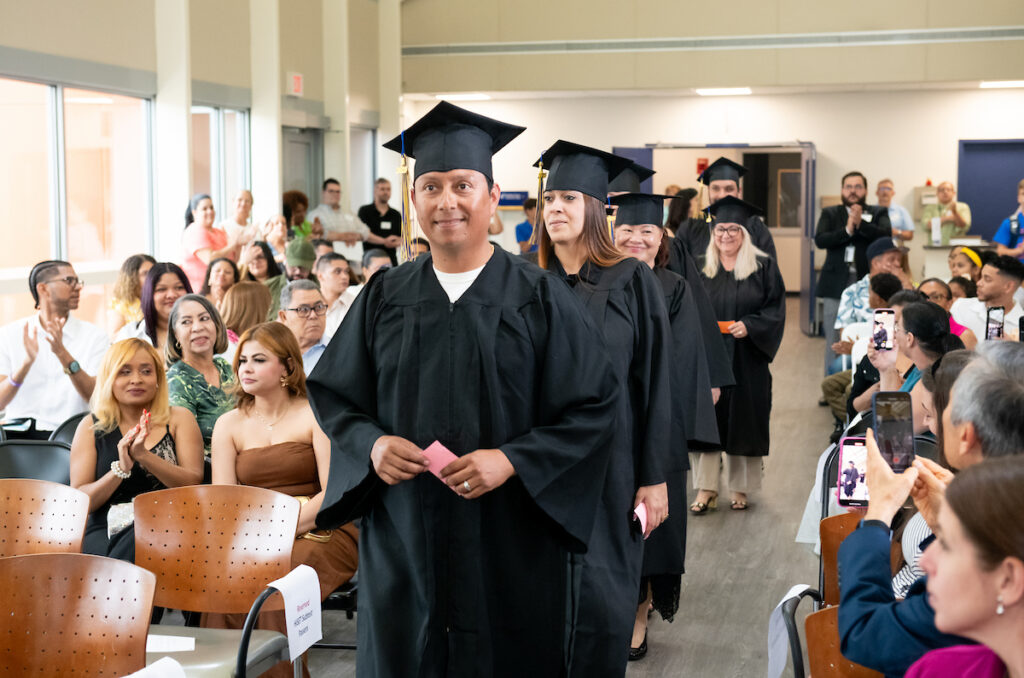NOTE: This article appeared in the July 14, 2025 edition of Community College Daily and the August 3, 2025 edition of CommonWealth Beacon.
At the recent graduation ceremony for Northern Essex Community College’s Center for Adult Education, we celebrated the accomplishments of 24 students who had completed their High School Equivalency exams, dozens more who finished English for Speakers of Other Languages (ESOL) programs, fifteen inductees into the National Adult Education Honor Society, and six newly naturalized citizens of the United States, who, waving American flags, treated the crowd to a surprise performance of “God Bless America.”
Adult education programs like these are offered by community colleges, school districts, and non-profit organizations across the country, and are in high demand by people seeking a second chance at improving their lives through education; by employers looking for talented, credentialed workers in a tight labor market; and by immigrants drawn to the promise of America.

Today, these programs are in danger of elimination, as the Trump administration has announced that $716 million in adult education program funding that was supposed to be distributed to states by July 1 is being withheld, pending a wider review of resources allocated to education, under suspicion that, according to a spokesperson at the Office of Management and Budget, “Many of these grant programs have been grossly misused to subsidize a radical leftwing agenda.”
The funding announcement was followed by letters sent by the U.S. Department of Education to colleges rescinding guidance that had been in place since 1997 that allowed federal funds to be used for undocumented residents in some adult education programs, and instead notifying them that the “Ending Taxpayer Subsidization of Open Borders” executive order signed by President Trump in February is intended to “prevent spending of American taxpayer dollars on Federal assistance for illegal aliens,” and therefore, colleges should no longer admit undocumented students into these programs.
While the focus in these recent announcements is on ending federal support for undocumented residents, it is clear from other White House communications and actions that the broader agenda is to practically eliminate immigration into the United States entirely.
In both of his terms in office, the Trump administration has taken aim at each of the principal ways that people from other countries can become naturalized United States citizens, including:
- Family-Based Sponsorship: A way for a U.S. citizen or lawful permanent resident to sponsor close relatives for a green card that President Trump has derided as “chain migration,” and vowed to curtail by reducing the categories of eligible family members, increasing income requirements, and imposing stricter, more time-consuming vetting processes.
- Employment-Based Sponsorship: A way for an employer to sponsor a foreign national for a green card with a qualifying job offer that President Trump is aggressively trying to limit through stricter interpretation of H1-B visa requirements, setting higher wage requirements for work visas, and enhanced vetting of visa applications, which slows processing time and presents barriers for employers seeking to fill vacant positions.
- Refugee or Asylee status: A process used to recognize individuals fleeing their home country because of a fear of persecution that the Trump administration has nearly eliminated by suspending the U.S. Refugee Admissions Program, suspending asylum applications for anyone attempting to cross America’s southern border, and ending Temporary Protected Status designations for asylees from Afghanistan, Haiti, Honduras, Nicaragua, and other strife-torn nations.
These steps are in addition to the Trump administration’s attempts to end birthright citizenship, which has been guaranteed by the 14th Amendment to the Constitution since 1868; and severely limit the number of international students studying at American universities through travel bans, suspension of visa interviews, social media vetting, and other steps designed to dissuade aspiring scholars from other countries from considering American higher education.
Despite this array of restrictions on everyday people attempting to emigrate to the United States, President Trump has proposed, and even set up a web site for wealthy foreigners interested in applying for, the “Trump Card,” which offers U.S. citizenship to anyone willing to pay $5 million for the privilege.
The president is not alone in pursuing these immigration restrictions. Although it passed by the narrowest possible margin in Congress, the recently enacted “One Big, Beautiful Bill Act” contains a number of provisions, like a 300% increase in funding for Immigration and Customs Enforcement (ICE), $45 billion for construction of ICE detention facilities, and $46 billion for border wall construction, designed to deter would-be immigrants to America.
Taken together, President Trump’s executive orders since January and his signing of the “One Big, Beautiful Bill” Act represent a radical shift in federal policy toward immigrants based largely on myths and misinformation, like claims that immigrants, many of whom are violent and take American jobs or rely on welfare assistance, are overrunning the U.S. population, when in fact:
- The proportion of foreign-born residents of the U.S. is unchanged. The United States is home to the largest immigrant population in the world. Yet, despite concerns expressed by some that the American immigrant population has been growing out of control, the proportion of immigrants to the overall population of the United States remained relatively unchanged over more than a century. According to the Migration Policy Institute, in 1910 14.7% of U.S. residents were born in other countries. Today, that figure is slightly lower, at 14.3%.
- Immigration is stabilizing our population. In 1950, Massachusetts was the 9thlargest state in the nation. Over the years, other states have grown faster than us. According to Boston.com, Massachusetts has experienced a net migration of native-born citizens out of the state each year since 2011, and we have slipped to 16th place in population size. Immigration has been the only way we did not actually lose overall population. And the same is true across New England, which has the oldest average population of any region in the country and, as the Federal Reserve Bank of Bostonhas noted, is being reenergized through immigration. The consequences of losing population are significant, and include a smaller workforce, fewer consumers, and fewer representatives in Washington.
- Immigrants are educated: According to the Migration Policy Institute, 48% of recently arrived immigrants have a college degree, compared to only 38% of native-born Americans.
- Immigrants are law-abiding: America has a long history of fear mongering when it comes to immigrants and refugees. After importing tens of thousands of Chinese workers to help build the railroads in the 1860s, America decided that Chinese immigrants were destroying our culture and stealing jobs, and passed the Chinese Exclusion Act in 1882. A decade later, German and Italian immigrants were rumored to be anarchists, and the Irish (including my ancestors) were declared terrorists (and drunkards). During the Great Depression in the 1920s and ‘30s, nearly two million Mexicans were targeted for “repatriation” and deported or scared into voluntarily emigrating—regardless of whether they held U.S. citizenship. And the list goes on…
Now, one of the big fears about immigrants seems to be crime, and accusations that those seeking asylum or citizenship are violent criminals. But numerous studies over the years have demonstrated conclusively that immigrants commit fewer crimes and have lower rates of incarceration than native-born U.S. citizens.
- Immigration improves our economy: According to a study from the Wharton School of Business at the University of Pennsylvania, “Most economists agree that the effects of immigration on the U.S. economy are broadly positive,” and include:
- Increased wages: Immigrants often do not compete for the same jobs as native U.S. citizens, putting minimal downward pressure on wages. Rather, immigrants’ consumer needs increase the demands for goods and services, and studies find that immigration has actually raised average wages of native-born workers over the past few decades.
- Improved innovation:Immigrants account for a disproportionately high share of patent filings, science and technology graduates, and senior positions at top venture capital-funded firms. In addition, the presence of immigrants often creates opportunities for less-skilled native workers to become more specialized in their work, thereby increasing their productivity.
- Higher tax revenue:Contrary to one often expressed belief, most immigrants, including those in the country without authorization, pay significantly more in taxes over a lifetime than they consume in government services. According to a report by Pew Research, immigrants in the U.S. illegally contribute more than $12 billion annually in state and local taxes. And get this: the average estimated tax rate of unauthorized immigrants is 8 percent, while the wealthiest one percent of Americans pay just over 5 percent. And, approximately 75 percent of unauthorized immigrants contribute to social security—a benefit they are not even eligible to receive.
- Saving retirement: The U.S. population is getting older. In 1990, there were five workers in America for every retiree. Now, there are only three. Without immigration, by 2030 that ratio will fall to only two—not enough to sustain our population of retirees.
Over the past few national election cycles, our nation has seemingly swung from one extreme (“Open Borders”) to another (“Build Walls”) as each party has sought to impose its vision for immigration on a population that appears equally divided over which way to turn.
A few years ago, political commentator Thomas Friedman, ever the pragmatist, suggested that what we really need is “A high wall with a big gate,” an approach that would balance our very real need for national security and social cohesion with our equally compelling need for shoring up our aging, birth-rate-declining population with the energy and vibrancy of immigrants seeking a better way of life.
The last time Congress passed meaningful comprehensive immigration reform that moved us in that direction was nearly forty years ago, when President Reagan signed the Immigration Reform and Control Act of 1986, which imposed penalties on employers who knowingly hired undocumented immigrants and increased funding for border security, but also provided amnesty and a path to citizenship for nearly three million undocumented immigrants.
President Reagan, and indeed leaders of both political parties until recently, recognized the importance of immigration to the very essence of what it means to be an American.
In his final speech as president, which is worth taking a few minutes to watch as a reminder of why he was called “The Great Communicator,” Reagan noted, “We lead the world because, unique among nations, we draw our people—our strength—from every country and every corner of the world. And by doing so we continuously renew and enrich our nation.”
Then he cautioned, “If we ever close the door to new Americans, our leadership in the world would soon be lost.”
Four decades later, under the policies being implemented by the Trump administration, we are rapidly spiraling in the direction Reagan feared for the nation.
He added one more particularly poignant point that was inescapably obvious to the crowd watching those half-dozen newly naturalized American citizens wave their flags and sing “God Bless America” at last week’s graduation ceremony: “Those who become American citizens love this country even more.”






